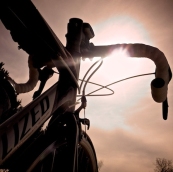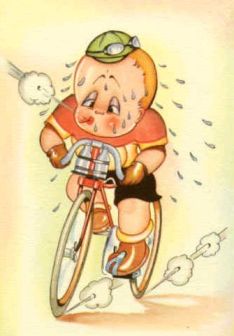More information about hydration can be found in Nutrition for Cyclists: Eating and Drinking Before, During and After the Ride which can be purchased on Amazon.com. For information about the book and how it relates to what I’ve posted to Tuned In To Cycling, please check out this post.
It’s hot. It’s humid. Even worse, it’s hot and humid. How do you handle heat and humidity on a ride? You already know the answer. Hydrate. Is there anything else you can do? Yes, but hydration is far and away the most important thing you need to combat heat and humidity. Understanding how heat and humidity affects you when you’re riding (or engaging in any other kind of exercise) can help you counter their ill effects.
How the body keeps cool
“Normal” body temperature is a slippery concept because many factors such as the time of the day, how temperature is measured, your state of athletic training, and where you are in your menstrual cycle if you are a woman (among other things) affects body temperature. For most cycling purposes, exact measures of normal body temperature along with exact measures of safe increases in body temperature aren’t very useful. You’re not going to know what your body temperature is while you’re riding because you’re not going to be taking rectal temperature measurements while you’re on the bike. Also, it doesn’t really matter what constitutes a “safe” increase in body temperature because you are going to be stressing your body’s ability to maintain that safe level when you ride.
The human body is a homeostatic system. This means it adapts to changing environmental circumstances in order to maintain certain physical and physiological parameters within acceptable boundaries. One of the most important of these parameters is core temperature. Combating heat and humidity is mainly about keeping core temperature down.
 Our bicycles are extraordinarily efficient machines. Under optimal circumstances approximately 99% of the energy put into the pedals is transferred into forward motion; only 1% is lost. Unfortunately, our bodies are not nearly as efficient. Approximately 75% of the energy generated by physical activity is lost as heat. The heat generated by our muscles raises body temperature when we exercise. The harder you go, the more heat you make and the more stress you place on your body to shed that heat and keep core temp down.
Our bicycles are extraordinarily efficient machines. Under optimal circumstances approximately 99% of the energy put into the pedals is transferred into forward motion; only 1% is lost. Unfortunately, our bodies are not nearly as efficient. Approximately 75% of the energy generated by physical activity is lost as heat. The heat generated by our muscles raises body temperature when we exercise. The harder you go, the more heat you make and the more stress you place on your body to shed that heat and keep core temp down.
There are two main ways the human body sheds heat. When the temperature of the body is higher than the temperature of the surrounding environment heat is shed through conduction and radiation. Here’s how this works for the cyclist. Your working muscles generate a lot of heat. Much of this heat is transferred to the blood which carries it away from the working muscles. When blood temperature reaches a particular threshold, vasodilation (expansion of the blood vessels at the surface of the body) occurs which brings a larger proportion of the blood into close contact with the surface of the body where it can shed its heat to the surrounding environment. When you stand close to a person who has been exercising hard you can feel the heat coming off their body. That’s heat that has been shed through conduction and radiation.
Conduction and radiation can only reduce body heat if the surrounding environment is at a lower temperature than the body. If air temperature is higher than body temperature, the body takes on heat from the environment. If you are riding on a hot day, conduction and radiation aren’t going to be nearly sufficient to shed the heat you’re generating.
The second way the body sheds heat is through evaporative cooling. When core temp rises to a critical threshold, the sweat glands are triggered and sweat is produced on the surface of the skin. The sweat evaporates and the evaporation cools the body. Under most circumstances, and especially when it is hot outside, evaporative cooling is the main way the cyclist sheds heat.
How increased core temp can hurt you
When you exercise your core temp rises. When core temp rises you sweat. When you sweat you lose fluid. If you lose enough fluid you become dehydrated. Dehydration and overhydration are important issues for the cyclist that are taken up in the post Dehydration and Over Hydration (Hyponatremia) for the Cyclist.
Even low levels of dehydration can affect performance. Loss of 2% body weight through fluid loss has measurable negative effects on athletic performance. Holding fluid loss constant, the negative effects increase the longer you ride or the hotter it is when you ride. As fluid loss increases beyond 2% body weight., the negative effects of dehydration increases rapidly and markedly. This is the good news.
The bad news is that loss of body fluids can produce severe dehydration and heatstroke. The symptoms include headache, nausea and vomiting, sweating stops or is severely reduced, very rapid breathing and heart rate, confusion, delirium, loss of consciousness, death. Heatstroke is a life threatening medical emergency. In a lifetime of athletic activity that has produced broken bones, snapped tendons, knocked out teeth, severe lacerations and several surgeries, the one time I suffered serious heatstroke (while running in competition) was – easily, hands down, no contest, and by far – the worst physical experience of my athletic life. You don’t want to go there, it’s terrible.
How all of this affects the cyclist
 Heat is bad. As the air temperature rises, the difference between body and air temperature decreases which weakens or eliminates conduction and radiation as methods of shedding heat.
Heat is bad. As the air temperature rises, the difference between body and air temperature decreases which weakens or eliminates conduction and radiation as methods of shedding heat.
Humidity is worse. Evaporative cooling is the primary way humans shed heat and it becomes even more important when exercise is producing a lot of excess heat. Humidity is an index of the amount of water vapor in the air; the higher the humidity, the more the air is saturated with water. The more the air is saturated with water, the less water it can take on which means that sweat is less likely to evaporate. The body continues to produce sweat so that evaporative cooling can bring body temperature down, but the sweat rolls off the skin rather than evaporating and cooling the body.
The air flow produced by moving on the bike can be a help here. When you stand still and sweat the air around you becomes saturated and sweating produces less evaporative cooling. When you’re rolling on the bike, the air around you is constantly being refreshed with air that is less saturated.
Heat combined with humidity is the worst of all. High heat coupled with high humidity sabotages both of the body’s mechanisms for shedding heat. The high air temperature reduces or eliminates conduction and radiation and the high humidity reduces evaporative cooling.
What can you do about it?
First and foremost – HYDRATE. Drinking water won’t cool you directly but it will replace the fluid you’re losing to sweat. This is critical for avoiding dehydration and heatstroke. Don’t screw around with this. Heatstroke can kill you.
How much should you drink? It depends on how much fluid you are losing to sweat and this will vary as a function of many factors such as how hot it is and how hard you’re working. Don’t use feeling thirsty as an indicator of whether or not you need to drink. The body is relatively slow to send thirst and hunger signals. You will usually have lost 1% to 2% of your body weight in fluid loss before you get the thirsty signal. By that time you’re already losing the battle of shedding excess body heat. A common mantra for cyclists is “Drink before you’re thirsty.” It’s great advice. Drink small amounts often rather than large amounts less frequently.
It’s possible to overhydrate which can lead to a condition called hyponatremia where there are abnormally low levels of sodium in the body (the excess water dilutes the sodium). This can also be life threatening although it rarely is. When hydrating your goal is to continually replace the fluid you lose through sweating without going to extremes with either too much water or not enough. For the cyclist riding in heat and humidity it’s better to err on the side of limiting dehydration as opposed to limiting hyponatremia. Don’t prepare for riding by drinking liters of water beforehand and be sensible on the bike. A future post will look at hyponatremia in more detail.
Wear the right clothing. No clothing at all would be optimal but sunburn, chafing from the bicycle seat and indecency laws make that impractical. If you’re not going to go nude, you want form fitting clothing that wicks moisture. Loose clothing traps air between the cloth and your skin which acts as insulation and reduces evaporative cooling. Wicking material moves the sweat from your skin to the air where it can evaporate and cool you. Cycling clothing has both of these properties so if you wear tight fitting cycling shorts and jerseys, you’re good. If you ride in a loose fitting cotton shirt, you’re asking for trouble when it’s hot and humid.
If you’re not racing, consider ramping down your work level on hot and humid days. If you ride at a slower pace, your leg muscles aren’t working as hard and are producing less excess heat.
If you have enough water, pour it on yourself. Evaporating sweat and water both produce evaporative cooling. Remember, though, that the water will do more to help you when it’s inside your body than when it’s on the outside. Don’t become dehydrated because you poured your water over your head.


Good post for this time of year
Very nicely written. Thank you. What’s your opinion about this scenario;
its a hot and humid day, the ride will be 3 to 4 hrs of hard work. Is it better to start with two bottles of sports drink (Gatorade) or one sports drink and one fuel drink (Perpetium)? Refueling will happen half way into the ride.
Thanks for the kind words. There are a couple of things to think about when you’re deciding whether to start with 1 water bottle + 1 mixed bottle of sports or fuel drink or 2 bottles of a mixed drink. First of all, if you start with 2 mixed bottles will you drink enough to meet your fluid needs in order to keep dehydration in check? Many mixed drinks can quickly become cloying and they often leave a coating in the mouth that can be tasted for awhile. Personally, I don’t like this and almost always follow a mixed drink with water to clear the taste out of my mouth when I’m on the bike.
Another consideration is how sensitive you are to carb concentration in the stomach. Drinking nothing but a sports drink that is high in carbs can lead to nausea for people with a low tolerance for carb concentration in the stomach.
Also, will your route allow you to easily refill your bottles with water if needed? If you start with 2 mixed bottles and find it isn’t working it’s easy to fix if you can stop and replace the mixture in one bottle with water.
Personally, I always have a bottle of plain water with me on the bike but there are a lot of individual factors at play here. Like a lot of things, there’s no simple rule that works for what to put in your bottles. The only simple rule that works is stay hydrated.
Hi, thanks for the information. I grew up in the Fort Lauderdale area and the heat index is regularly over 100F in the summer so hydration is critical. I drink 8oz of a sports drink every 15 minutes (I have an alarm set) so I take film containers of the hydration powder and after my bottles are empty I stop along the beach and fill the bottles and add the powder. As you can imagine I go through a lot of fluids. Twice I’ve gotten to the point where I stopped sweating and could barely pedal in my easiest gear. I went under a tree and drank a bunch of fluid and waited until I cooled off quite a bit. It is pretty scary. I’m the type that doesn’t back off when it’s hot but know I should. I usually let my HRM tell me when I’m too warm. It is around 10-15 BPM more than normal when it’s hot.
Thanks again
Pingback: Cycling and Weight Loss Part 2: Metabolic Homeostasis | Tuned In To Cycling
Pingback: Back to cycling in Japan’s heat | Travels on various bikes ;-)